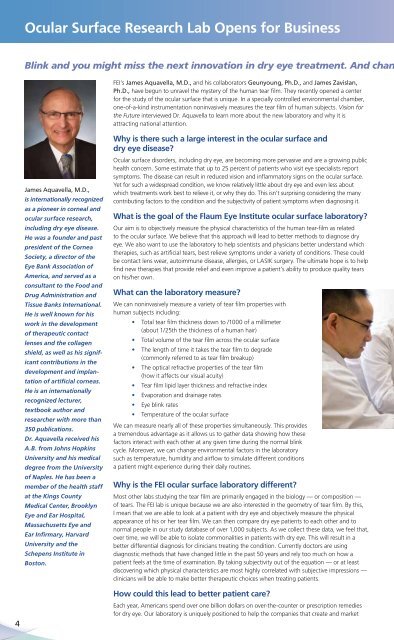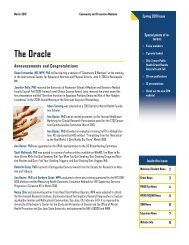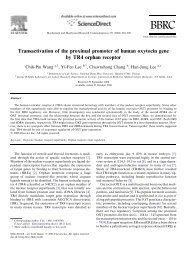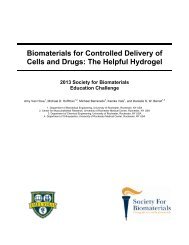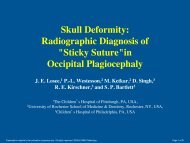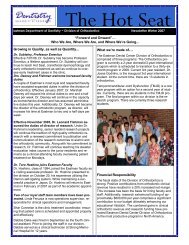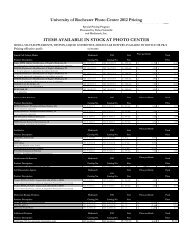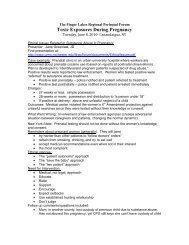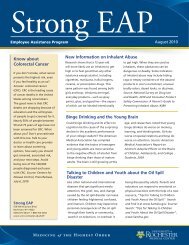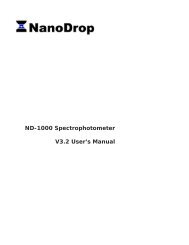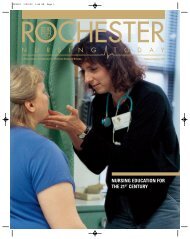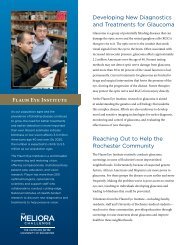INSIDE - University of Rochester Medical Center
INSIDE - University of Rochester Medical Center
INSIDE - University of Rochester Medical Center
You also want an ePaper? Increase the reach of your titles
YUMPU automatically turns print PDFs into web optimized ePapers that Google loves.
4<br />
Ocular Surface Research Lab Opens for Business<br />
Blink and you might miss the next innovation in dry eye treatment. And chan<br />
James Aquavella, M.D.,<br />
is internationally recognized<br />
as a pioneer in corneal and<br />
ocular surface research,<br />
including dry eye disease.<br />
He was a founder and past<br />
president <strong>of</strong> the Cornea<br />
Society, a director <strong>of</strong> the<br />
Eye Bank Association <strong>of</strong><br />
America, and served as a<br />
consultant to the Food and<br />
Drug Administration and<br />
Tissue Banks International.<br />
He is well known for his<br />
work in the development<br />
<strong>of</strong> therapeutic contact<br />
lenses and the collagen<br />
shield, as well as his significant<br />
contributions in the<br />
development and implantation<br />
<strong>of</strong> artificial corneas.<br />
He is an internationally<br />
recognized lecturer,<br />
textbook author and<br />
researcher with more than<br />
350 publications.<br />
Dr. Aquavella received his<br />
A.B. from Johns Hopkins<br />
<strong>University</strong> and his medical<br />
degree from the <strong>University</strong><br />
<strong>of</strong> Naples. He has been a<br />
member <strong>of</strong> the health staff<br />
at the Kings County<br />
<strong>Medical</strong> <strong>Center</strong>, Brooklyn<br />
Eye and Ear Hospital,<br />
Massachusetts Eye and<br />
Ear Infirmary, Harvard<br />
<strong>University</strong> and the<br />
Schepens Institute in<br />
Boston.<br />
FEI’s James Aquavella, M.D., and his collaborators Geunyoung, Ph.D., and James Zavislan,<br />
Ph.D., have begun to unravel the mystery <strong>of</strong> the human tear film. They recently opened a center<br />
for the study <strong>of</strong> the ocular surface that is unique. In a specially controlled environmental chamber,<br />
one-<strong>of</strong>-a-kind instrumentation noninvasively measures the tear film <strong>of</strong> human subjects. Vision for<br />
the Future interviewed Dr. Aquavella to learn more about the new laboratory and why it is<br />
attracting national attention.<br />
Why is there such a large interest in the ocular surface and<br />
dry eye disease?<br />
Ocular surface disorders, including dry eye, are becoming more pervasive and are a growing public<br />
health concern. Some estimate that up to 25 percent <strong>of</strong> patients who visit eye specialists report<br />
symptoms. The disease can result in reduced vision and inflammatory signs on the ocular surface.<br />
Yet for such a widespread condition, we know relatively little about dry eye and even less about<br />
which treatments work best to relieve it, or why they do. This isn’t surprising considering the many<br />
contributing factors to the condition and the subjectivity <strong>of</strong> patient symptoms when diagnosing it.<br />
What is the goal <strong>of</strong> the Flaum Eye Institute ocular surface laboratory?<br />
Our aim is to objectively measure the physical characteristics <strong>of</strong> the human tear-film as related<br />
to the ocular surface. We believe that this approach will lead to better methods to diagnose dry<br />
eye. We also want to use the laboratory to help scientists and physicians better understand which<br />
therapies, such as artificial tears, best relieve symptoms under a variety <strong>of</strong> conditions. These could<br />
be contact lens wear, autoimmune disease, allergies, or LASIK surgery. The ultimate hope is to help<br />
find new therapies that provide relief and even improve a patient’s ability to produce quality tears<br />
on his/her own.<br />
What can the laboratory measure?<br />
We can noninvasively measure a variety <strong>of</strong> tear film properties with<br />
human subjects including:<br />
• Total tear film thickness down to /1000 <strong>of</strong> a millimeter<br />
(about 1/25th the thickness <strong>of</strong> a human hair)<br />
• Total volume <strong>of</strong> the tear film across the ocular surface<br />
• The length <strong>of</strong> time it takes the tear film to degrade<br />
(commonly referred to as tear film breakup)<br />
• The optical refractive properties <strong>of</strong> the tear film<br />
(how it affects our visual acuity)<br />
• Tear film lipid layer thickness and refractive index<br />
• Evaporation and drainage rates<br />
• Eye blink rates<br />
• Temperature <strong>of</strong> the ocular surface<br />
We can measure nearly all <strong>of</strong> these properties simultaneously. This provides<br />
a tremendous advantage as it allows us to gather data showing how these<br />
factors interact with each other at any given time during the normal blink<br />
cycle. Moreover, we can change environmental factors in the laboratory<br />
such as temperature, humidity and airflow to simulate different conditions<br />
a patient might experience during their daily routines.<br />
Why is the FEI ocular surface laboratory different?<br />
Most other labs studying the tear film are primarily engaged in the biology — or composition —<br />
<strong>of</strong> tears. The FEI lab is unique because we are also interested in the geometry <strong>of</strong> tear film. By this,<br />
I mean that we are able to look at a patient with dry eye and objectively measure the physical<br />
appearance <strong>of</strong> his or her tear film. We can then compare dry eye patients to each other and to<br />
normal people in our study database <strong>of</strong> over 1,000 subjects. As we collect these data, we feel that,<br />
over time, we will be able to isolate commonalities in patients with dry eye. This will result in a<br />
better differential diagnosis for clinicians treating the condition. Currently doctors are using<br />
diagnostic methods that have changed little in the past 50 years and rely too much on how a<br />
patient feels at the time <strong>of</strong> examination. By taking subjectivity out <strong>of</strong> the equation — or at least<br />
discovering which physical characteristics are most highly correlated with subjective impressions —<br />
clinicians will be able to make better therapeutic choices when treating patients.<br />
how could this lead to better patient care?<br />
Each year, Americans spend over one billion dollars on over-the-counter or prescription remedies<br />
for dry eye. Our laboratory is uniquely positioned to help the companies that create and market


